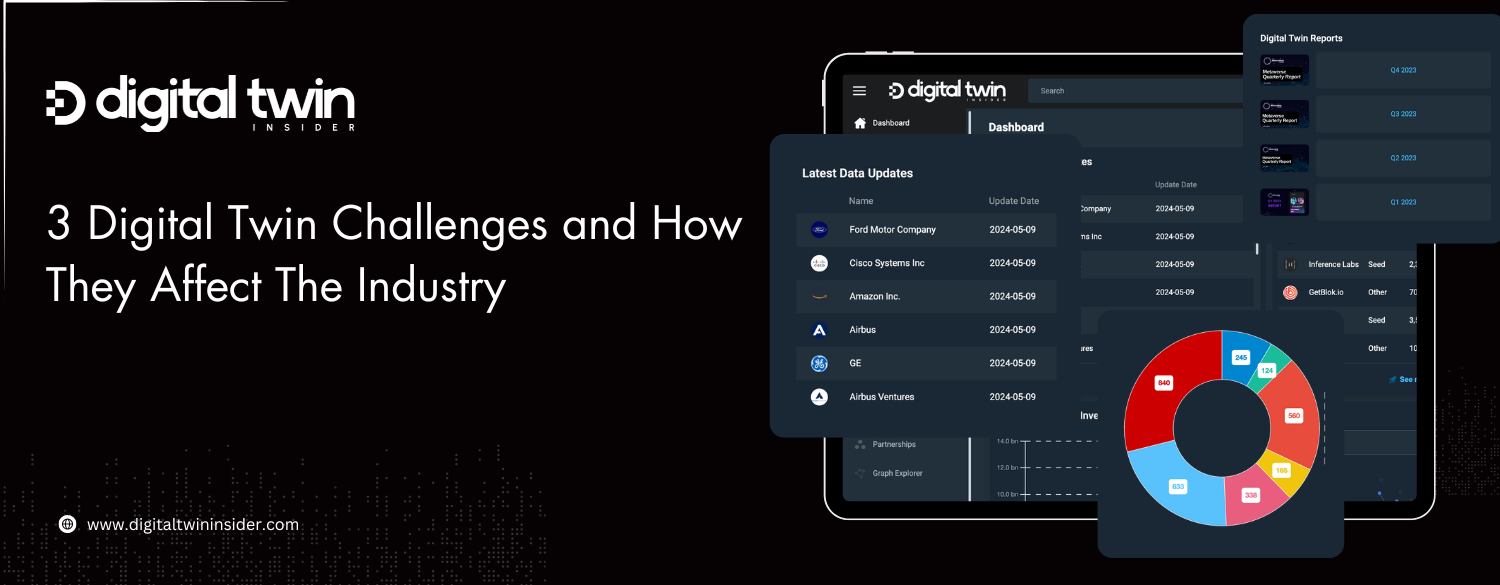Introduction
The digital twin industry is robust and complex, consisting of providers and end users building and using the underlying technology of digital twins to revolutionize the future of sector development. This article explores digital twins’ challenges and how they impact the digital twin industry and further afield markets. Key points covered include:
- Core challenges.
- The long-term benefits of overcoming these issues.
- The applications of digital twins across sectors.
What Are Digital Twins?
Digital Twins are advanced technologies that are characterized by three essential components. First, a twin must be a direct 1-1 digital replica of a physical counterpart. This is a digital replica of a physical entity, often built using building information models, otherwise known as BIM. These replicas are exact copies and are mapped 1-1 in representation.
Notable examples of digital replication include the leading software development company Solid Clouds, which is developing a digital replica of the Almere Bus Station in the Netherlands. Alongside 1-1 mapping, digital twins must have realistic physics comparable to their physical counterparts.

Essentially, this involves digital twins’ functions that behave in a way that mimics the real world. For example, a digital twin of a building must behave and function like a building and not be gamified in any way.
Thirdly and critically, digital twins must have two-way data feedback. The data feedback must be instantaneous and involve data fed to the digital twin from a physical counterpart. Likewise, digital twins must feed data to the real world, making decisions based on data to influence physical entities and their actions. Thus, unlike static simulations, data is integral to digital twins and how they function.
Alongside digital replicas, digital shadows are often confused as a term describing digital twins. Digital shadows use data but consist of a single flow of data. Digital Shadows involve a physical counterpart feeding data to a digital shadow for informed decision-making in the real world. However, unlike digital twins, the shadow does not feed data from the twin to the real world, changing the functions of the physical entity. Instead, the data is a single flow, with the digital shadow usually comprising of a mathematical equation.
Digital twins combine both digital replicas and shadows, but with the addition of two-way instantaneous data feedback and realistic physics, they create a twin. Essentially, this is the nuts and bolts of a digital twin, with providers globally, such as ANSYS, developing solutions for customers. A recent example is the European Union’s Destination Earth digital twin, which looks to create a twin of the Earth to track weather patterns and the impact of climate change.
Read also: 5 Best Digital Twin Software Solutions In 2024
3 Key Digital Twin Challenges
The digital twin industry faces numerous challenges that could hinder digital twin adoption. Below are examples of the key issues.
1. Education Gap
The complexity of technologies presents an education gap in all emerging technology markets. Although the gap varies depending on the complexity of technology, the education gap is large within the deep technology space. Specifically, within digital twins, there is limited education on the use and application of digital twins and how twins are built. End users and customers need more education to make informed decisions, such as what providers they should go with. Although providers have done an admirable job in helping to disseminate their digital twin technologies, a gap exists with no single source for unbiased information on building, operating, and using digital twins.
Likewise, users need more data on return on investment outcomes for digital twins, with information scattered around the internet in often confusing and unhelpful formats. The Digital Twin Insider looks to fill this void through its data platform and publication.
Overall, education is key to unlocking market potential and addressing challenges. If providers want to onboard more customers, these end users must be sufficiently educated on the benefits of digital twins and their functions.
2. Interoperability
Interoperability is among the key digital twin challenges the industry must overcome to fulfill its potential. Interoperability refers to the ability of computer systems to transfer and exchange information. Although a relatively trendy word often associated with the Metaverse and the blockchain folks of web3, interoperability is applicable in the digital twin space. The ability of digital twin systems to exchange information and work together to achieve objectives is a must for an industry still growing.
Limited interoperability restricts the ability of digital twin systems to work together, hindering project objectives and limiting productivity and outcomes. For example, a digital twin built by a provider for a customer may not be compatible with a user who wants to use another platform, such as PTC ThingWorx. A simple example at best, interoperability is a key challenge for the industry that can hinder growth if not tackled.
Luckily, companies like NVIDIA and Siemens are pioneering interoperability standards through Open USD, enabling providers to integrate their digital twin software into platforms like NVIDIA Omniverse.
Omniverse has dozens of software integrations, enabling customers and providers to use their digital twin software within the platform to build twins. Examples include the ability to use Autodesk Revit and Bentley Systems iTwin.
Interoperability is the key to a successful industry. Innovators like NVIDIA are working hard to champion OpenUSD as the leading digital twin software integration tool.
Read also: Top 8 Digital Twin Platforms In 2024
3. Cost to Entry
As previously highlighted in our feature piece on the differences between simulation and digital twins, compared to other forms of digital replica, digital twins are expensive from the offset and have significant cost implications that may have high barriers to entry for some businesses.
Although less of a problem for larger organizations with the capital to invest in building digital twins. Currently, the entry cost needs to be lowered for most. Due to the complexity of digital twins, the price is high, with most digital twin providers offering monthly access to their platforms. Examples include NVIDIA Omniverse, which costs $5000 monthly for the enterprise edition, which is far from the higher end of the spectrum, with platforms such as iTwin costing substantially more. It is also worth noting that these platforms only provide the tools for building digital twins, with the development process up to the companies, further increasing costs. For bespoke digital twin solutions, the costs vary but are substantial.
As the digital twin industry develops, the cost of these services will decrease as the technology becomes more readily available. Therefore, the entry cost will likely be a short-term rather than a long-term challenge.
Long-term Benefits of Overcoming Digital Twin Challenges
The long-term benefits of overcoming the challenges laid out above are vast. Solving the interoperability issues and cost of entry and limiting the information gap are all essential to industry growth and success. Each of the digital twin challenges outlined in this article becomes an opportunity for further development for stakeholders in the market. Productivity is the key here, with the long-term benefits being increased ROI, better outcomes, and higher profits. Providers and end users should work together to ensure interoperability standards are met across the industry. Education is also fundamental, with better-educated customers being able to reduce their costs when developing digital twins, consequently lowering the price of entry.
Read also: Digital Twin Market Size 2024: Current State & Future Trends
Applications of Digital Twins in Various Industries
Digital Twin technology has various applications across industries. As mentioned earlier in this article, within the climate technology industry, the European Union has begun its digital twin project of the Earth known as Destination Earth to track weather patterns in tackling climate change. Likewise, within the agriculture sector, experts at Carnegie Mellon University are using digital twins to improve the delivery of nutrients for plants to reduce and limit the impact of agriculture on the environment.
Similarly, on the side of conservation, La Trobe University and the Australian Institute of Marine Science (AIMS) have developed a digital twin of the Great Barrier Reef to assist in coral reef recovery. Digital twins are also being used in the development of fusion reactors and have started to be adopted by various robotics companies, such as Taiwanese company Pegatron, through platforms such as NVIDIA Omniverse. These are just a few examples of how digital twins are used across industries, often addressing various challenges.
Read also: 15 Best Digital Twin Companies To Watch In 2024

Future of Digital Twins in the Industry
Digital Twins have a bright and promising future. Due to their unique ability to increase operational efficiency across the board, from robotics manufacturing to environmental conservation, digital twins will revolutionize industries globally in the future. As barriers to entry come down and challenges are resolved, digital twins will see rapid adoption due to their many benefits. Digital twins play a vital role in Industry 4.0, making industrial processes more digital. For more information on digital twins’ role in industry 4.0 development, check out our industrial Metaverse report in partnership with world-leading digital twin providers.
Conclusion
This article has outlined the challenges facing the digital twin industry, such as interoperability, education, and cost of entry, as well as the long-term benefits of overcoming them. For more insight into the data used in this article, check out our intelligence platform for the latest insights.
If you found this article to be informative, you can explore more current Digital Twin news here exclusives, interviews, and podcasts.













